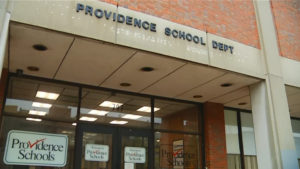Beyoncé and many others have said, “When life gives you lemons, make lemonade.” This is particularly true during the myriad crises presented by our current pandemic. But even before COVID-19, way back in the summer of 2019, it was all lemons for educators in Providence, RI. A blistering report from the Johns Hopkins Institute told us we had provided an “exceptionally low level of academic instruction” and that our “school culture is broken”. The new School Commissioner said there was not one public school in Providence she would trust with her children. As a Providence teacher and parent, it was excruciating. It was hard not to feel that my parenting had been impugned and that my own work was part of the problem, even with the obligatory recognition of “devoted” and “heroic” teachers.
As the state prepared to take over the Providence Schools last fall, I began a little takeover of my own.
I started with the end in mind: students using their own data analysis to present their ideas about improving Providence Schools to Rhode Island Department of Education officials.
And because I am a statistics teacher, I thought: What if the Johns Hopkins report became our introductory statistics curriculum? My students are truly at the center of this education crisis and are living it every day. Some have spent their entire K-12 education in the city’s public schools, and there is rising student activism in response to recent developments. All this makes me ask: Who better to advise the state on what the schools need than those who are most impacted?
So that’s what we did. Throughout last fall, my statistics students—almost all of whom are students of color, and more than a third of whom are English Language Learners—worked on one-variable data analysis using data on or relevant to the Providence Schools takeover. I showed coverage of the Johns Hopkins report and the ensuing community meetings from local TV news and we read and took notes on key sections of the 93-page report. We used my favorite math questions, “What do you notice? What do you wonder?” to assess the graphs and tables included in the report. They created histograms, box plots, bar charts examining survey data about Providence Schools, calculated measures of center and spread and answered higher-order questions based on the evidence they uncovered.
This intense focus on the problems of the very system most of them were schooled in was not easy. Many students reacted to the data as I had with dismay and anger. As they reviewed the report, they immediately tried to guess which schools had been among the 12 described anonymously in it. “They didn’t visit any of the good schools,” was a common refrain. At the same time, they told stories of the very findings in the report that are so heartbreaking: out-of-touch teachers, a rotating cast of substitutes, violent situations and crumbling buildings. Most are seniors and they were frustrated improvements hadn’t happened sooner. “Why are they fixing things now, when we are about to leave?” And the most ambitious among them worried how their “trash” school system would affect their college acceptances. To the extent possible, we focused on the positive. For example, they used their knowledge of “outliers” to identify ways that our own school stood out in the data.
I also wanted students to connect what they were learning with their own experiences, both at our high school and in other schools. Over the summer, I talked with my colleague who teaches English to many of the same students. With his guidance, students had spent part of the first quarter writing and producing “The Moth” style personal stories. Using the same rubric and graphic organizers the English Department had distributed, I asked my math students to write a description of a pivotal moment in their education experience. Many students resisted the requirement to “write in math class” but doing so surfaced some very personal tales of how school had fallen short, and in many cases, how it boosted their life ambitions.
By the end of the quarter, they were ready to use their new skills to analyze data and make recommendations to improve Providence Schools.
I began by presenting my own version of the project I assigned them, including my recommendations for improving the school system, so they would know what they were working toward. As a class, and in partners, we reviewed the data available focusing on the constructs from the Panorama Student Survey, an annual survey of public school students in Rhode Island. This survey clusters questions into topics, such as School Safety, Student Engagement and School Climate. Students reviewed the description of the topic and the types of questions included. Then they answered questions in their Research Guide to make the connection to their Education Story. This helped them develop their storyline for their presentation and focus their analysis.
In my Statistics class, I emphasize data science skills and access to user-friendly data, so students developed 5-number summaries and box plots comparing the Providence High Schools to either charter high schools in Rhode Island, other district high schools in the state, or both. They also had to draw on their notes from the Johns Hopkins report and their own education story to provide evidence for their topic’s importance. Finally, they researched and refined solutions and made recommendations to the state. Students had four days in class to draft their slides, and several students spent extra time after school to complete the work. I reviewed their slides over a weekend and gave them feedback on the content, and they had two more in-class days to make changes and practice their presentations.
Then it was time to present! All students had access to the presentation template, sample presentation and presentation sentence starters for each slide. Additionally, I or an English Language Development colleague (who supports one period of my class 2-3 days per week) worked one-on-one with English Learners to develop their scripts for the presentation. Then I arranged for Rhode Island Department of Education (RIDE) Office of Innovation staff to attend the in-class presentations. Each student provided warm and cool feedback to their peers. Based on that, as well as my own feedback, three pairs were selected to present to the new Superintendent, whose first day on the job was February 22.
Then, three weeks later, before we could even invite him to one of our school-wide town halls, our school, like every other school in the state, was closed due to the coronavirus pandemic.
Lessons Learned from Student-Centered Data Projects
As one might imagine, reforms related to the Schools Takeover have taken a backseat to distance learning and pandemic planning. In late June 2020, the Rhode Island Department of Education and Providence Public Schools released, “Turning Hope into Results: A Turnaround Action Plan for the Providence Public School District,” which focused on identifying benchmarks for improvement but presented few specific strategies. Since the strategies have not been identified, one positive outcome is that I will be able to refine this project for 2020-21 Statistics students so that it better supports their learning and activism.
I’m particularly interested in how I can help students identify the systemic causes of the underinvestment in Providence Schools and the political nature of the report.
One of the things I underestimated was how upsetting this information would be to students. As much as I tried to focus on improvement, many students were overwhelmed by the negative press reports and the generally poor data. The recent activism across the nation against systemic racism has also made me wonder how I can develop this project so it is intentionally anti-racist. As a White teacher, I feel fortunate to be in a school where I am supported to work for justice every day, but I know I need to develop my teaching and curriculum so that I am part of the solution, not part of the problem.
Over the last several weeks, I have been reading or re-reading work from Zaretta Hammond, Rochelle Gutierrez, Robin DiAngelo, Francis Su and Beverly Daniel Tatum. Over the summer, my planning will involve more explicit attention to how I can help students deconstruct perceptions of schools and districts across racial, gender and class lines. I will be posting later this summer about my efforts to make this project more intentionally anti-racist, and welcome any ideas you might have. You can reach me at ellenlfoley@gmail.com.

Ellen Foley is a Students at the Center Distinguished Fellow with the Student-Centered Learning Research Collaborative at KnowledgeWorks. She is a STEM Learning Facilitator at 360 High School in Providence, RI where she teachers Statistics, Pre-calculus and Computer Science.

